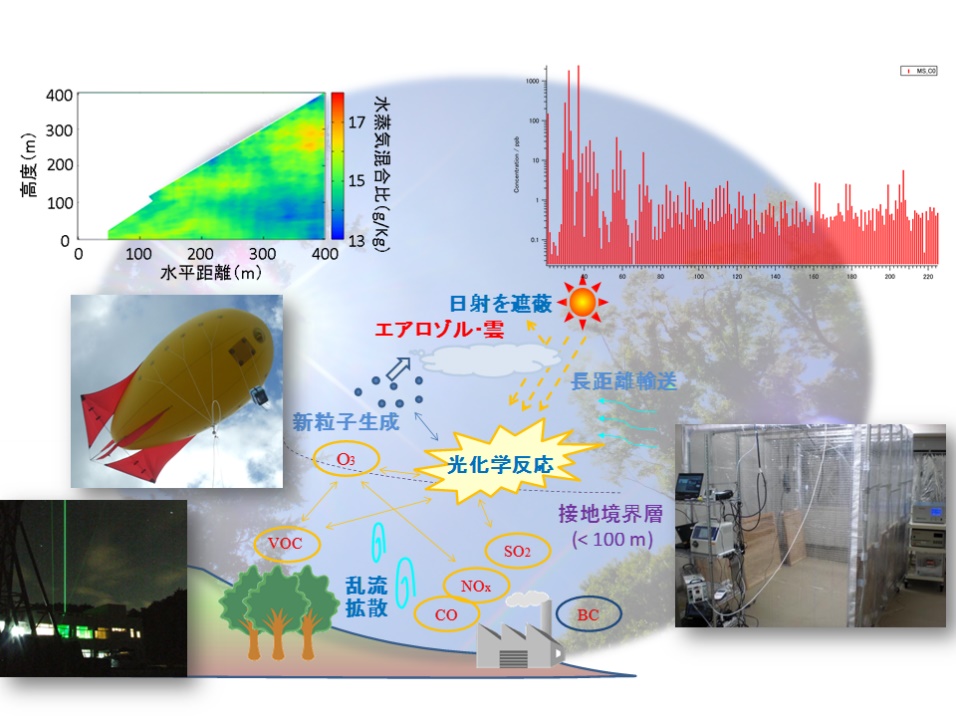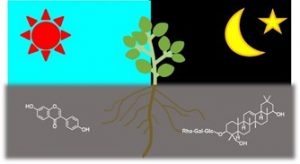2021 Activity Report for Mission 5-1: Harmonization of Human Health and the Environment
Updated: 2022/06/01
Research 1-1: Production of bioactive compounds from plant biomass
Principal Investigator (PI): Takashi Watanabe (RISH, Kyoto University)
Research collaborator(s): Hiroshi Nishimura, Chihiro Kimura, Yumi Okabe, Tatsuya Miyazaki (RISH, Kyoto University), Ryota Ouda (Graduate School of Medicine, Hokkaido University), Takashi Fujita (Institute for Frontier Life and Medical Sciences, Kyoto University), Osamu Matsuda, Eriko Ohgitani, (Graduate School of Medicine, Kyoto Prefectural University of Medicine)
We studied production of antiviral and antitumor compounds by microwave degradation of wood and sugarcane bagasse in collaboration with Institute for Frontier Life and Medical Sciences, Kyoto University and Kyoto Prefectural University of Medicine, aiming at establishment of safe and healthy living and biorefinery. In FY 2021, the mechanism emerging antiviral activity by lignin degradation products separated from microwave degradation products of sugarcane bagasse was analyzed, and their growth inhibitory activity against various enveloped and non-enveloped viruses was analyzed, and the results were published in a paper (Fig. 1). In addition, an antiviral lignin-carbohydrate complex was isolated from acidic solvolysis products of wood, and the results were published in a paper.
we found that chemical degradation of wood and sugarcane bagasse produced antiviral lignin by alteration of its chemical structure. We also found that microwave solvolysis of woody biomass produced antiviral lignin-carbohydrate complex (LCC) in which carbohydrate chains play a key role for the activity.
Antiviral lignin and lignin-carbohydrate complexes (LCCs) for improving human living and animal husbandry environment
Publications, etc.
1.Original article
1) Chihiro Kimura, Seong-Wook Oh, Takashi Fujita and Takashi Watanabe, Adsorptive inhibition of enveloped viruses and nonenveloped cardioviruses by antiviral lignin produced from sugarcane bagasse via microwave glycerolysis, Biomacromolecules, 23, 3, 789–797 (2022).
2) Li, R., Ouda, R., Kimura, C., Narita, R., Nishimura, H., Fujita, T., Watanabe, T., Conversion of beech wood into antiviral lignin-carbohydrate complexes by microwave acidolysis, ACS Sustain. Chem. & Eng., 9, 28, 9248–9256 (2021). https://doi.org/10.1021/acs.biomac.1c01209
2.Presentation
1) Takashi Watanabe, Production of antiviral substance from plant biomass, invited lecture in “Fiber-related technologies for the post-corona era” organized by The Textile Machinery Society of Japan, Oct 29,2021, online
2) Takashi Watanabe, Dissolution of plant biomass under extremely mild condition and creation of sustainable society through lignin-first biorefinery, The 44th seminar of the Advanced Fiber Materials Research Committee and the seminar of the fiber finishing research committee Kansai Branch -Innovation toward a decarbonized society, Dec 15, 2021, Uji
3) Chihiro Kimura, Seong-Wook Oh, Takashi Fujita and Takashi Watanabe, Production of antiviral lignin from sugarcane bagasse by microwave glycerolysis and its functional analysis, the 66th Lignin Symposium, Nov 4-5, online.
Research 1-2: Production mechanism of bioactive compounds and biotechnology
Principal Investigator (PI): Kazufumi Yazaki (RISH, Kyoto University)
Research collaborator(s): Akifumi Sugiyama (RISH, Kyoto University), Ryosuke Munakata (RISH, Kyoto University), Bunta Watanabe (ICR, Kyoto University), Kojiro Takanashi (Shinshu University), Alain Hehn (Université de Lorraine INRA), Frédéric Bourgaud (PAT France), Hirobumi Yamamoto (Toyo University), Kenji Matsui (Yamaguchi University), Takao Koeduka (Yamaguchi University)
Many lipophilic plant secondary metabolites exhibit strong biological activities, and some are prescribed in clinical fields, e.g., vincristine and paclitaxel serving as anti-cancer drugs. For those compounds, the lipophilicity is a key physicochemical feature to exhibit the activities in the cells due to their high membrane permeabilities. However, a large portion of their biosynthesis and secretion mechanisms from the cells remain to be clarified.
One of such lipophilic secondary metabolite group, prenylated phenols, shows a variety of biological activities to humans, such as anti-cancer, anti-microbial, and anti-tyrosinase activities, etc. In 2021, we focused on the prenyltransferase involved in the biosynthesis of bergamottin, a prenylated coumarin contained in grapefruit juice, which is widely known as an inhibitor of drug metabolizing enzyme of human. We identified a O-prenytransferase responsible for the formation of bergamottin from grapefruits. This is the first O-prenyltransferase found in plants. It is expected that this gene is utilized as a molecular marker for breeding of citrus species free from bergamottin. Furhter pharmacological applications, e.g., attacking cancer cells are also expected.
Publications, etc.
- Ichino, T., Yazaki, K., Modes of secretion of plant lipophilic metabolites via ABCG transporter-dependent transport and vesicle-mediated trafficking, Curr. Opin. Plant Biol., 66: 102184 (2022).
- Koeduka, T., Takarada, S., Fujii, K., Sugiyama, A., Yazaki, K., Nishihara, M., Matsui, K., Production of raspberry ketone by redirecting the metabolic flux to the phenylpropanoid pathway in tobacco plants, Metab. Eng. Commun., 13, e00180 (2021).
- Munakata, R., Olry, A., Takemura, T., Tatsumi, K., Ichino, T., Villard, C., Kageyama, J., Kurata, T., Nakayasu, M., Jacob, F., Koeduka, T., Yamamoto, H., Moriyoshi, E., Matsukawa, T., Grosjean, J., Krieger, C., Sugiyama, A., Mizutani, M., Bourgaud, F., Hehn, A., Yazaki, K., Parallel evolution of UbiA superfamily proteins into aromatic O-prenyltransferases in plants, Proc. Natl. Acad. Sci. USA, 118 (17), e2022294118 (2021).
Research 1-3: Establishment of unit reaction for biological production of antitumor lignans
Principal Investigator (PI): Toshiaki Umezawa (RISH, Kyoto University)
Research collaborator(s): Keisuke Kobayashi, Masaomi Yamamura, Yuki Tobimatsu (RISH, Kyoto University)
Lignan is a class of phenylpropanoid dimers liked via C8-C8′ side chains of two phenylpropane units. Lignan has various biological activities. Among them, podophyllotoxin is an anti-tumor lignan and establishment of a stable biolotechnological production systems of the lignan is desired. In this study, we have attempted to clone cDNAs encoding enzymes involved in the antitumor lignan biosynthesis and to characterize the enzymes. In this school year, we successfully characterized enzyme gene encoding 2-oxoglutarate-dependent dioxygenase (2ODD), which catalyzes cyclization reaction of yatein downstream of the pathway. In addition, we characterized O-methyltransferases (OMTs) that are involved in yatein biosynthesis.
Publications
- Kobayashi K, Yamamura M, Kumatani M, Ono E, Shiraishi A, Satake H, Umezawa T, The 38thAnnual Meeting of the Japan Society for Plant Biotechnology, Tsukuba (on-line), September 9-21, 2021 (Oral)
Research 1-5: Identification of transporters for bioactive compounds and their application for production
Principal Investigator (PI): Akifumi Sugiyama (RISH, Kyoto University)
Research collaborator(s): Yuichi Aoki(Tohoku University)、Atsushi J. Nagano(Ryukoku University)
We also analyzed diurnal transcriptome of soybean and identified several candidate transporter genes for isoflavone and soyasaponin transport. We also analyzed transcriptome of tomato leaves and roots grown in a field, and selected candidate genes which are potentially involved in tomatine secretion.
Publication
- Nakayasu M., Ohno K., Takamatsu K., Aoki Y., Yamazaki S., Takase H., Shoji T., Yazaki K., Sugiyama A. (2021) Tomato roots secrete tomatine to modulate the bacterial assemblage of the rhizosphere. Plant Physiology 186:270–284.
Research 1-6 : Application and basic research of fine bubble water for sustainable environment
Principal Investigator (PI): Yoshikatsu Ueda (RISH, Kyoto University)
Research collaborator(s): Pan Li (Tongji Univesrity, China), Masateru Hirae (Science Co. Ltd.), Yomei Tokuda (Shiga University)
Fine bubble water, which is created using common air and water, is expected to improve cleaning effectiveness and save water. In this international joint research project, we would like to work on environmental research using fine bubble water and investigate fine bubble’s effects. We will collaborate with the Chinese side in large-scale experiments. We have been working as a cross-disciplinary research project in Japan and have been conducting research in collaboration with actual equipment manufacturers. We investigate the basic properties of bubbles and make clear their mechanism of action from an electrical and a chemical perspective, as well as the environmental engineering aspects of the actual cleaning effects in each field.
(Li, et. al., 2022)
Publications etc.
- P. Li, J. Wang, Z. Liao, Y. Ueda, K. Yoshikawa and G. Zhang, Microbubbles for Effective Cleaning of Metal Surfaces Without Chemical Agents, Langmuir, 2022/Jan/05
- T. Sato, Y. Ueda, K. Takahashi and K. Takaki, Sterilization and virus inactivation by fine bubbles, Japanese Journal of Multiphase Flow(in Japanese),35, 2, 251-258, 2021/June
- (Invited speech) Y. Ueda, Introduction of research studies on sterilization and virus inactivation using fine bubbles, The 17th International Symposium of Fine Bubbles, 2021/Dec/13
- (Invited speech)Yoshikatsu Ueda, Yomei Tokuda, Yoshiharu Hidaka, Cleaning Effect of Utrafine Bubble Water Spraying by Orifice Nozzle, Kyoto University Finebubble Workshop, 2021/12/08
- (Inviter speech) Y. Ueda, 「Environmentally Friendly Fine Bubbles – Latest Application Research Cases and Basic Characteristics」, The 39th Kyoto University Industry-University Cooperation Meeting, 2021/Sep/27
Research 3: Air quality issues in outdoor and indoor environments
Principal Investigator (PI): K. Takahashi and M. Yabuki (RISH, Kyoto University)
Human activities increasingly influence the Earth’s climate and ecosystems. For instance, humans change the atmospheric aerosol loadings by emitting primary aerosol particles and a variety of trace gases that could be chemically transformed to give aerosol particles. Aerosol particles impact the Earth’s climate on a regional and global scale. Our study aims to develop in-situ and remote sensing techniques for observing trace gases and aerosol particles and their applications to outdoor and indoor measurements, which is closely linked to air quality issues in outdoor and indoor environments. In FY2021, we have developed an eye-safe mobile vehicle lidar to monitor urban pollutants with high spatio-temporal resolutions. In addition, we have made an attempt to measure nitrogen dioxide flux using a LED-based spectrometer in the central of Sakai-city, Osaka-Prefecture.

Development of new techniques for exploring spatio-temporal variations of atmospheric trace molecules and aerosol particles in outdoor and indoor environments.
Publications
- K. Takahashi, Atmospheric chemistry studies in forest and urban environments by applying laser spectroscopy techniques, The 1st International Conference of Lignocellulose (ICON-LIG) in conjunction with the 10th International Symposium for Sustainable Humanosphere (ISSH), 13-14 September, 2021. (invited)
- M. Yabuki, Y. Ishii and K. Miura, Horizontal aerosol distributions near the ground by a mobile vehicle lidar , 39th Japanese Laser Sensing Symposium, September 1-3, 2021.




-300x156.png)

-300x161.png)
